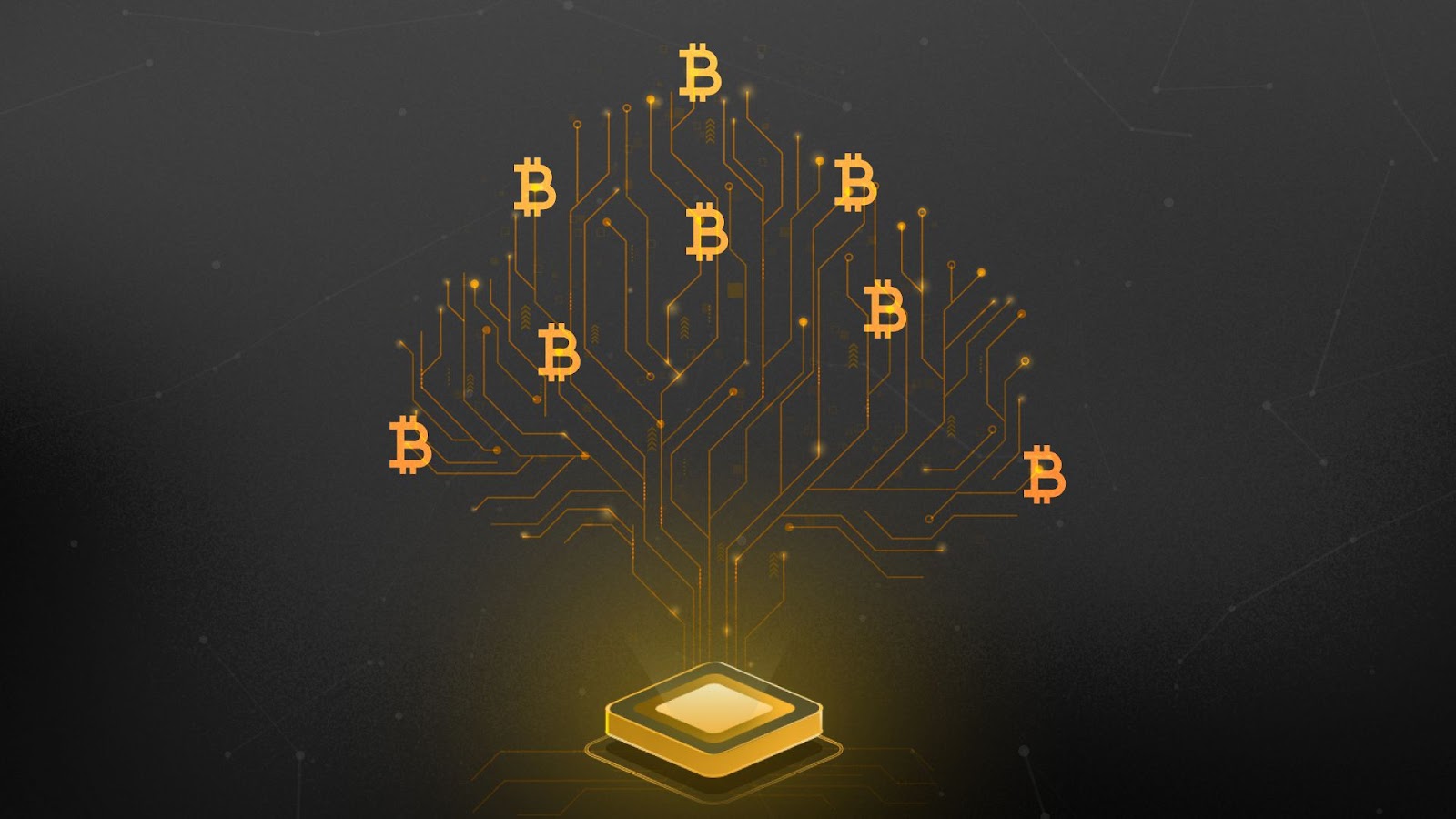Bitcoin
Bitcoin CPI
Venture Portfolio
Funds
Market Insights
Indicators
About
Contact

November 18, 2024





Several new protocols are augmenting Bitcoin’s utility and functionality by taking advantage of previous soft forks. The Taproot Assets Protocol is one of them.
Read on to learn about the Taproot Assets Protocol, one of the newest Bitcoin layers set to broaden Bitcoin’s ecosystem.
Taproot Assets, previously Taro, is a Taproot-powered protocol that is set to allow users to issue fungible and non-fungible tokens on the Bitcoin blockchain.
It was introduced by Lightning Labs at the end of 2022. Its goal is to bring asset issuance to Bitcoin.
Taproot Assets Protocol (TAP) is based on the Taproot Bitcoin upgrade implemented in November 2021. The upgrade enables developers to embed an asset’s metadata within an existing, unspent transaction output (UTXO). It also uses Schnorr signatures for better scalability and simplicity, as well as Lightning compatibility.
TAP permits users to transfer assets over the Lightning Network (LN), allowing them to enjoy near-instant and affordable transactions. Therefore, it leverages the scalability, speed, and cost-effectiveness of Lightning while, at the same time, utilizing the stability and security of the Bitcoin network.
Lightning Labs launched Taproot Assets v0.2 in May 2023. The release is in the testnet stage. Taproot Assets was ultimately inspired by RGB, a similar version for bringing assets to Bitcoin built by the LNP/BP association.

Now, let’s take a look at how the Taproot Assets Protocol works.
Taproot Assets is a protocol directly relying on the Bitcoin upgrade called Taproot, implemented in November 2021. Among other improvements, Taproot aggregates signatures and lets multiple, complex signatures be verified together, which reduces the blockspace requirements, making operations cheaper and more scalable.
Bitcoin’s UTXO model goes hand in hand with this. This is the amount of BTC that remains after a transaction, from which other, new transactions are initiated.
With the implementation of Taproot, Bitcoin transactions can be more efficiently structured, allowing for complex scripts to be represented as simple transactions, thus optimizing block space usage.
Taproot, combined with concepts such as taptweak and sparse Merkle trees, enhances the verification of complex conditions and smart contracts by allowing more data to be handled without significantly increasing on-chain data size.
Although these elements can streamline transaction verification and enable certain off-chain computations, the actual verification of data and consensus still occurs on-chain. This optimization leads to more effective use of block space, rather than an increase in block space itself.
In other words, Taproot Assets relies on several different cryptographic concepts, all of which were made possible through the Taproot upgrade, to embed metadata into existing UTXOs. This metadata, which sets the criteria for the asset’s creation, is then committed and published, can be separately verified, and allows for the transfer of these assets according to the owner’s will.
Users can issue assets on TAP using its client on the Bitcoin main chain. Asset issuance on the protocol involves making a Bitcoin transaction and paying transaction fees in BTC.
A Taproot asset is considered to be live once it has been issued and its genesis transaction has been verified on the blockchain. Only then can the asset be transferred. Issuers must define an asset’s rules when minting a fungible or non-fungible token. For example, the rules can state what the total supply of an asset is and whether it is capped. The Taproot Assets client is responsible for cryptographically enforcing the supply controls of assets.
TAP permits multiple assets to be controlled by the same output. It also allows users to aggregate many transactions into a single UTXO. These functions enable the protocol to optimize unspent transaction outputs.
The Taproot Assets Protocol is compatible with the Lightning Network. This makes it even more powerful because issued assets can be deposited into Lightning channels and transferred between parties.
Additionally, assets can be transferred over the Lightning Network without leaving the Layer 2 protocol.
Taproot asset transfers are only known by the participants of a Lightning channel. The asset transfer looks like any other Lightning transfer to routing nodes.
Taproot Assets enables a payment-routing model where the Lightning Network can handle channels with any asset. If a route denominated in a given asset doesn’t exist, the asset is converted to BTC and routed to its destination, where it is swapped back. Routing fees are paid to LN nodes.
In the latest update, edge nodes (which are the routing nodes used by Taproot Assets to interact with the rest of the Lightning Network) can send out a Request for Quote (RFQ), which lets a user generate an invoice to their edge node for a time-limited price quote between the asset in question and bitcoin.
The edge note can offer its quote, either from an exchange or from a collection of exchange APIs, and the receiver can accept it or ask for a new, more favorable one. When a quote is accepted, it is signed and accepted in a way that makes it indistinguishable from any other invoices.
Another update includes trustless, non-custodial, on-chain swaps. Partially Signed Bitcoin Transactions (PSBTs) are used to atomically swap assets for BTC or for different assets in a way that doesn’t require the swapping parties to interact but also does not rely on centralized coordinators while remaining trustless.
Finally, Taproot Assets now include multi-sig support for an additional layer of security, plus time-locked cold keys that users can fall back on in the event that their hot keys are destroyed.
Assets are held in a wallet that stores Taproot Assets keys and Taproot keys. The Taproot Assets wallet also knows which digital assets are held in which UTXOs.
To send a Taproot asset to someone, they must provide their Taproot Assets wallet address, which consists of the asset’s information and the public keys.

Taproot Asset Universe is a place where an asset’s details and proofs are stored. It contains information about which assets have been issued, their rules, quantity, and proof of recent transfers. A universe operator is in charge of setting the criteria for releasing this data.
TAP also features a pocket universe that allows users to collectively batch their transactions and share on-chain fees. A pocket universe has control over the Taproot key to a UTXO. However, it doesn’t control the keys to the assets contained in that UTXO.
Taproot Assets brings asset issuance to the Bitcoin blockchain while offering users transactional privacy. It joins other projects like Ordinals and Runes, which are leveraging previous upgrades to expand Bitcoin’s ecosystem.
Nevertheless, Taproot Assets stands out for its compatibility with the Lightning Network. Therefore, it will be exciting to see the protocol’s impact once it is released to the public.
Taproot is the second major upgrade implemented on Bitcoin since its inception. It introduced privacy, Schnorr signatures, and the ability to add more functionality to the blockchain.
These improvements have allowed developers to create projects such as Ordinals and the Taproot Assets Protocol (TAP) without making any changes to the underlying base layer blockchain, such as smart contract functionality. As a result, Bitcoin-native fungible and non-fungible tokens can now be issued directly on the most secure blockchain today.
Taproot assets are fungible or non-fungible tokens issued on Bitcoin using the Taproot Assets Protocol (TAP). The protocol derives its name from its reliance on the Taproot upgrade. It uses the upgrade to embed asset metadata into a UTXO. TAP is also compatible with the Lightning Network. Therefore, users can deposit Taproot assets into Lightning channels and transact off-chain.